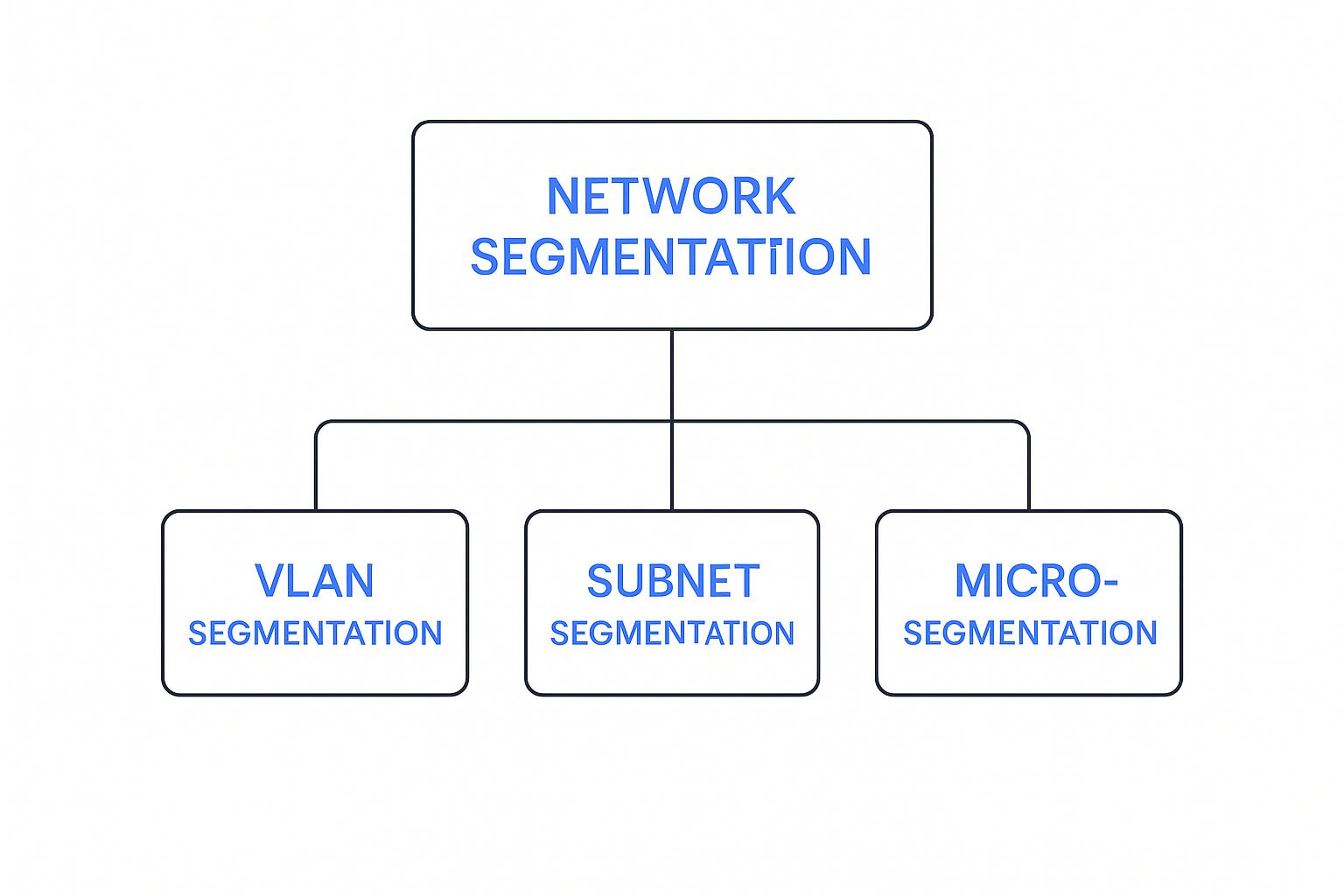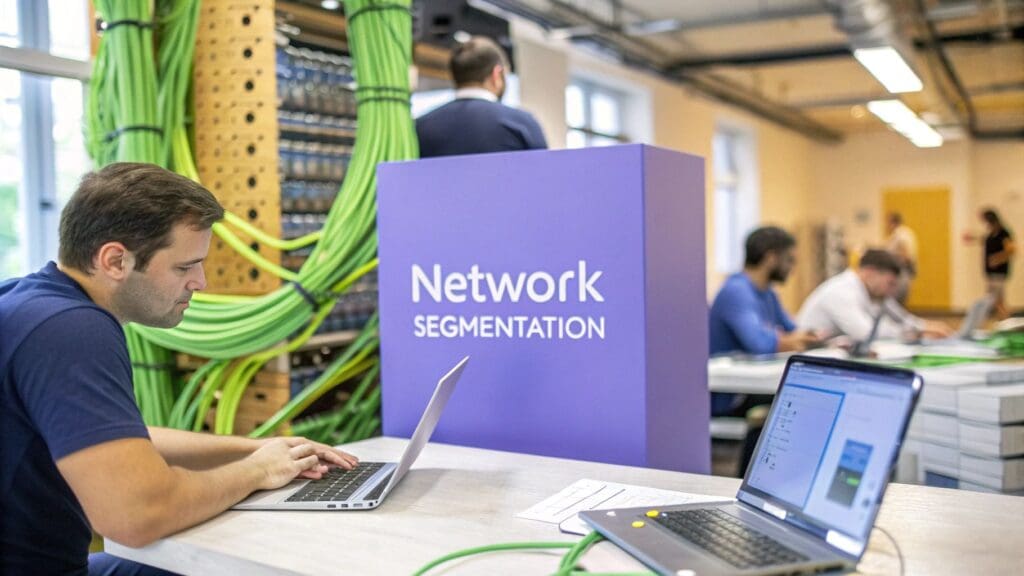Think of your company’s network as one giant, open-plan office. The reception desk, sensitive client archives, and your finance department’s records are all sitting out in the same open space. If a thief gets past the front door, they have access to everything.
Network segmentation is how we fix that. It's the digital equivalent of building secure, access-controlled departments within that office. You’re essentially putting up walls and adding locked doors between different areas, so someone hanging around reception can't just wander into the accounts office and rifle through confidential files.
Understanding What Network Segmentation Is

At its heart, network segmentation is the practice of breaking up one large computer network into smaller, isolated sub-networks, often called 'zones' or 'segments'. We use tools like firewalls and smart switches to enforce these internal boundaries, making sure a problem in one area doesn’t spread and compromise the entire system. It’s a foundational piece of any modern cybersecurity strategy.
This method of separation is critical. It transforms a vulnerable, flat network into a more defensible structure with multiple layers of security. Even if one segment is compromised, the breach is contained and cannot easily spread to other critical parts of your business.
This containment approach is a core principle of good security hygiene. It seriously limits the amount of damage an attacker can cause by restricting their movement once they're inside your network.
Creating Secure Zones
These smaller, isolated zones can be organised based on whatever criteria make the most sense for your business. There’s no single right way to do it, but some common approaches include:
- By Department: Creating separate zones for your design, accounts, and management teams.
- By User Role: Granting different levels of access for employees, freelancers, and clients.
- By Device Type: Isolating devices like printers, cameras, and guest Wi-Fi from the main corporate network.
Each zone gets its own security rulebook that dictates who can access it and what kind of information can flow between it and other zones. This is great for overall security, but it also helps protect the individual computers and devices within each zone.
The principles behind this are fairly straightforward but powerful when applied correctly.
Core Principles of Network Segmentation
Here’s a quick summary of the fundamental ideas behind creating a segmented network.
| Principle | Description |
|---|---|
| Isolation | Keep different parts of the network separate to prevent threats from spreading easily. |
| Containment | Limit the impact of a breach by confining it to a single, small segment. |
| Access Control | Enforce strict rules about who and what can move between different network zones. |
| Least Privilege | Grant users and devices only the minimum level of access they need to do their job. |
By following these principles, you build a much more resilient and secure environment for your creative work.
This approach works hand-in-hand with securing individual devices. To see how this fits into the bigger picture, you might find our guide on https://infrazen.tech/what-is-endpoint-security/ useful, as the two concepts are closely linked.
For a deeper dive into the technical side, there are plenty of resources covering the best practices for network segmentation that can help you get started.
Why Segmentation Is Essential for UK Creative Teams

Creative agencies are custodians of incredibly valuable digital assets, from pre-launch campaign files to sensitive client data. A single, flat network-where every single device can see every other device-is an open invitation for trouble. In this environment, network segmentation stops being a "nice-to-have" and becomes a non-negotiable security control.
This strategy is a direct response to the rising tide of cyber threats, creating internal barriers that protect your work. Think of it like this: if a fire starts in one room of a building, fire doors can stop it from consuming the entire structure. Segmentation acts as those fire doors for your digital workspace.
Containing the Damage from Breaches
The real power of network segmentation is its ability to contain a breach. Let’s say a freelancer connects to your guest Wi-Fi and accidentally introduces malware. Without segmentation, that threat could spread like wildfire across your entire network, potentially reaching critical servers holding project files, financial data, or client information.
With a segmented network, the guest Wi-Fi exists in its own isolated bubble. The malware is firewalled off and contained, unable to jump across to your core business systems. This isolation is vital for business continuity, ensuring a minor incident doesn't derail your entire creative production line.
A contained breach is the difference between a minor inconvenience and a catastrophic business failure. By isolating threats, you protect your most valuable assets and maintain operational stability, even when facing an active security incident.
The reality of cyber threats for UK businesses makes this strategy all the more urgent. The latest UK Cyber Security Breaches Survey revealed that 43% of businesses suffered a breach or attack in the last year. This figure skyrockets to 70% for medium-sized businesses and 74% for large ones, highlighting just how widespread the risk has become.
Addressing Unique Creative Workflows
Creative teams have unique ways of working that make segmentation especially relevant. The collaborative nature of the industry often means:
- Working with freelancers and contractors who need limited, specific access to project files-and nothing else.
- Using a diverse stack of software, where each application has its own potential vulnerabilities.
- Handling large, high-value media files that are prime targets for digital theft or ransomware.
A well-designed segmented network gives you granular control. You can build secure zones for specific projects or third-party collaborators, keeping everyone in their own lane. This approach aligns perfectly with modern security thinking. If you're looking to strengthen your defences, our guide to network security best practices offers more practical advice.
Ultimately, getting to grips with network segmentation is the first step toward building a more resilient and secure foundation for your creative business.
Exploring Different Types of Network Segmentation
Once you understand why you need to segment your network, the next question is how. There are a few different ways to carve up a network, but they mostly boil down to two main approaches: physical and logical segmentation. Each has its own pros and cons, suiting different needs and budgets.
Choosing the right path isn't about finding a one-size-fits-all answer. It’s about weighing your security needs against your operational flexibility and what you can afford. The best fit is always the one that makes sense for your creative agency's unique situation.
Physical vs. Logical Segmentation
Physical segmentation is the most direct method you can use. It involves using completely separate, dedicated hardware-think different switches, routers, and firewalls-to create a genuine "air gap" between different parts of your network. A classic example is running your guest Wi-Fi on entirely different kit from the network that holds your sensitive client files.
Logical segmentation, on the other hand, carves up a single physical network into multiple virtual sub-networks using software-based rules. This approach is much more flexible and usually more cost-effective.
The core trade-off is pretty straightforward: physical segmentation gives you maximum security but costs more and is less flexible. Logical segmentation offers fantastic flexibility and is easier on the budget, but it needs careful and precise configuration to be truly secure.
This infographic breaks down the most common logical approaches.

As you can see, methods like VLANs and Subnetting are the bedrock, while microsegmentation takes things to an even more granular level for tighter control.
Common Logical Segmentation Methods
When it comes to creating these virtual zones, a few methods are industry favourites:
-
VLAN Segmentation: Virtual Local Area Networks (VLANs) are a brilliant way to group devices together logically, even if they aren't plugged into the same physical switch. This is perfect for separating, say, the design team's high-powered Macs from the finance department's workstations.
-
Subnetting: This technique involves breaking down a large network into smaller, more manageable sub-networks, or "subnets." It’s great for reducing network chatter and improving security by giving you firm control over the traffic that flows between each subnet.
-
Microsegmentation: This is an even more fine-grained approach that can isolate individual workloads or applications from one another, essentially creating tiny security zones around each one. If you're working in the cloud, understanding Kubernetes security best practices is vital for making microsegmentation work effectively.
How to Implement Network Segmentation Effectively

Putting network segmentation into practice isn't about quick fixes; it requires thoughtful, strategic planning. The entire process is guided by one core security idea: the principle of least privilege.
This simply means giving users and devices access only to the network resources they absolutely need to do their jobs-and nothing more. This approach dramatically shrinks your attack surface. If a device is compromised, its access is already so restricted that an attacker has very little room to move, preventing a small breach from becoming a full-blown disaster. It’s a fundamental shift from a "trust by default" model to a much safer "verify first" stance.
The Foundational Steps for Implementation
A successful segmentation project starts with understanding what you have. After all, you can't protect what you don't know exists.
-
Identify and Classify Assets: First, take a full inventory of everything on your network-servers, laptops, printers, and especially sensitive data. Classify each asset based on its importance. Your client archive and financial records, for instance, are far more critical than the office smart speaker.
-
Map Data and Traffic Flows: Once you know what you have, you need to understand how everything communicates. Map the essential data flows between users, devices, and applications. This process reveals which connections are vital for business and, just as importantly, which are not.
-
Define Segment Boundaries: Using your data flow map, you can begin to draw logical boundaries. These segments can be organised by department (Design, Accounts), user role (Employee, Freelancer), or even by project, creating isolated zones for specific client work.
-
Establish Access Control Policies: With segments defined, you must create and enforce strict access rules. This involves configuring firewalls and switches to control traffic between zones, explicitly blocking any communication that isn't essential for a task.
For any of this to work, a solid grasp of effective network configuration management is crucial to maintaining your infrastructure's integrity over the long haul.
From Planning to Continuous Monitoring
Implementation isn't a one-time project; it's an ongoing process. As your creative team evolves-adding new staff, tools, and clients-your network segmentation strategy must adapt alongside it.
Continuous monitoring is non-negotiable. You must actively watch traffic between segments to spot unauthorised access attempts, identify misconfigurations, and ensure your policies remain effective over time. Without it, your carefully built walls can quickly develop unseen holes.
This proactive stance is rapidly becoming standard practice. According to recent findings, over half of UK companies (53%) planned to implement network segmentation within the next year, with another 32% aiming for rollout in the following one to two years. You can review the full report and learn more about these cybersecurity readiness trends. This highlights a clear, industry-wide recognition of segmentation's role in building a more secure and resilient business.
Defending Against Ransomware and DDoS Attacks
The whole idea of network segmentation really clicks when you see how it stands up against real-world threats like ransomware and Distributed Denial of Service (DDoS) attacks. These aren’t just abstract risks you read about; they are active threats that can completely paralyse a creative business. A well-designed, segmented network is one of the most practical and robust defences you can have against both.
Take ransomware, for example. Here, containment is everything. Imagine a designer’s laptop gets infected with malware. On a typical flat network, that infection could tear through your systems in minutes, encrypting every file on the main server and grinding your entire operation to a halt.
But with segmentation? That infected laptop is stuck in its own digital room, unable to reach or do any damage to the critical assets tucked away in other segments.
A well-segmented network turns a potential company-wide disaster into a manageable, isolated incident. The infection is stopped at the border of its segment, protecting your most valuable creative work and client data from being held hostage.
Keeping Core Services Online During an Attack
Segmentation is also a powerful ally against DDoS attacks, which are designed to flood your network with junk traffic and knock your services offline. And with these attacks becoming more common, it’s a defence you can’t afford to ignore. The problem is getting worse, with one report noting a 56% year-over-year increase in botnet-driven DDoS attacks against UK organisations. You can read more about the evolving UK cyber threat landscape on barriernetworks.com.
By separating your public-facing services (like your website) from your internal, mission-critical systems, you can absorb an attack without your core operations grinding to a halt. So, even if your website is targeted and becomes sluggish or unavailable, your team can keep working. Why? Because the production servers, file storage, and internal chat tools are all safely cordoned off in a separate, protected segment.
This kind of resilience is a tangible return on investment, showing how a smart network architecture directly supports business continuity. For creative agencies that need constant uptime and robust security, looking into managed cyber security services can provide the expert oversight needed to build and maintain these crucial defences.
Still Have Questions About Network Segmentation?
Whenever I talk to creative teams about network segmentation for the first time, a few key questions always come up. It's a concept that can feel a bit technical initially, but getting your head around the basics is crucial for making smart decisions about your agency’s security and day-to-day resilience.
Let's clear the air and tackle the most common ones.
A big one is whether this is all a bit overkill for smaller agencies. While it might sound like something only a massive corporation would need, modern tools have made it surprisingly affordable and straightforward to implement. Honestly, the cost of setting up some basic segmentation is tiny compared to the eye-watering cost of a single ransomware attack bringing your entire studio to a standstill.
The goal isn't instant perfection-it's about making meaningful progress. Just starting with simple steps, like creating a separate guest Wi-Fi and walling off your most critical servers, gives you a massive security upgrade without a huge upfront investment.
Let's Clear Up Some Common Mix-ups
Two points in particular often trip people up when they're new to the idea. Nailing these down will make the path forward much clearer.
-
How does segmentation help with GDPR?
The General Data Protection Regulation (GDPR) is all about protecting personal data, and segmentation is a fantastic tool for this. It lets you isolate the systems that handle personal information-like your client database or mailing list server-from everything else. By doing this, you're actively demonstrating that you’re taking technical steps to control access and limit exposure, which is a core principle of the regulation. -
What’s the difference between network segmentation and microsegmentation?
Here's a simple way to think about it. Network segmentation is like creating separate, secure departments in an office building (e.g., Accounts, Design, Client Services). Each one has its own locked door.Microsegmentation, on the other hand, is like putting a locked filing cabinet around every single desk within those departments. It's a much more granular approach that isolates individual apps or even specific workloads from each other. This offers an even higher level of security, and it's particularly useful in complex or cloud-based environments.
Ready to build a network strategy that lets your creative team focus on their work, securely and without interruption? InfraZen Ltd specialises in creating calm, resilient IT systems for agencies just like yours. See how we can help at https://infrazen.tech.

